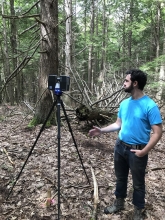You are here
How Do We Measure Carbon?

We know that forests store carbon, but how do we measure the carbon stored in trees without cutting them down? An international group of LiDaR (Light Detection and Ranging) scanning experts and forest scientists gathered at the Harvard Forest this August to compare scanning and destructive sampling methods to calculate tree volume, mass, and carbon.
Most researchers use equations that estimate mass (and carbon) based on simple, nondestructive measurements of diameter and species. Improving these equations, and exploring new methods of estimating mass from detailed LiDaR techniques is important to estimate forest carbon more accurately and efficiently.
The LiDaR activity was coordinated by Alan Strahler of Boston University, with funding from an NSF Research Coordination Network grant, and involved scientists from Massachusetts, Maine, Michigan, Virginia, Australia, Canada, and the United Kingdom. A large forest plot was scanned with various lidar instruments that can reconstruct the volume of complex objects including trees. Then the Harvard Forest Woods Crew felled 20 trees in the plot that were dissected into stem, branch, bark, and leaf components to provide direct measurements of tree mass. Three additional trees were scanned and then deconstructed and measured, branch-by-branch, from the top down using the Forest’s canopy lift.
- Explore a gallery of images from the process.

